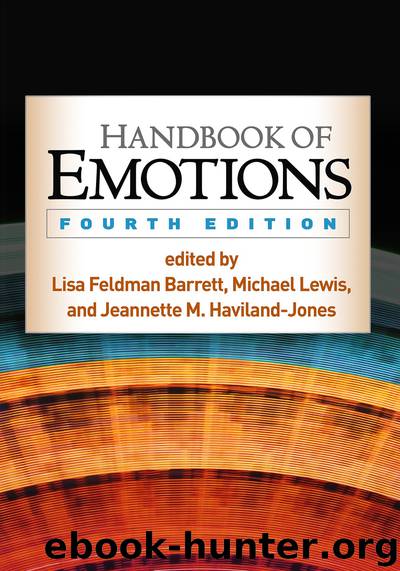Handbook of Emotions, Fourth Edition by Lisa Feldman Barrett Michael Lewis & Jeannette M. Haviland-Jones

Author:Lisa Feldman Barrett, Michael Lewis & Jeannette M. Haviland-Jones [Michael Lewis, Jeannette M. Haviland-Jones, Lisa Feldman Barrett]
Language: eng
Format: epub
ISBN: 9781462525362
Publisher: The Guilford Press
BEYOND THE FACE AND VOICE: TOWARD A SCIENCE OF MULTIPLE MODALITIES OF EMOTIONAL EXPRESSION
Emotional expression is a multimodal phenomenon. Darwin (1872/1998) himself referred to facial muscle movements and vocalizations, but also autonomic responses (the blush, pupil activity), movements of the arms and hands (clapping), shifts in posture, head movements, gestures, respiration, and full-body actions like jumping and dancing about. Darwin’s emphasis on dynamic behavior is also of note. With a few notable exceptions (see Krumhuber, Kappas, & Manstead, 2013; Nelson & Russell, 2011a, 2011b, for a review) though, the literature on facial expression has focused on static photos. Yet a great deal of information is likely contained in dynamic movement.
For the most part, however, the empirical literature on expression has removed the body from systematic inquiry (but see Atkinson, Dittrich, Gemmell, & Young, 2004; Kret, Pichon, Grèzes, & De Gelder, 2011, for exceptions) and focused narrowly on facial muscle movements or vocalizations. Attention to emotions like pride and embarrassment has necessitated the study of head, gaze, and bodily movements (Keltner, 1995; Tracy & Robins, 2004, 2007). There are select studies of other channels of nonverbal behavior, such as how emotions are communicated in patterns of posture (Dael, Mortillaro, & Scherer, 2012; Gross, Crane, & Fredrickson, 2010) and gaze (Graham & LaBar, 2007; Lobmaier, Tiddeman, & Perret, 2008; Sander, Grandjean, Kaiser, Wehrle, & Scherer, 2007). Clearly, Darwin’s (1872/1998) more comprehensive analysis suggests that there should be signal value in how emotions are communicated in a vast array of communicative behaviors, from simple movements of the hands to shifts in body posture to head movements. Relatively little is known about these intriguing possibilities.
Several recent studies have begun to capture how people convey emotion in tactile contact (Hertenstein & Weiss, 2011). Studying touch poses methodological challenges. Touch is dyadic, involves multiple regions of the body, and has many dimensions, including pressure, duration, location, and intensity. Touch does not lend itself to portrayals in classes of stimuli that can be used in typical emotion recognition paradigms. Notwithstanding these methodological issues, progress is being made in understanding which emotions have tactile signals.
Hertenstein and colleagues (Hertenstein, Keltner, App, Bulleit, & Jaskolka, 2006; Hertenstein, Holmes, McCullough, & Keltner, 2009) have begun to ascertain which emotions can be conveyed by touch. In a first study, an encoder (the person charged with touching another person to convey emotion) and decoder (the person being touched) sat at a table, separated by an opaque black curtain, which prevented communication other than touch. The encoder was given a list of emotions and asked to make contact with the decoder on the arm to communicate each emotion, using any form of touch. The decoder could not see any part of the touch because his or her arm was positioned on the encoder’s side of the curtain. After each touch, the decoder selected from 13 response options the term that best described what the person was communicating. In this study, participants could reliably communicate anger, disgust, and fear with a brief 1- or 2-second
Download
This site does not store any files on its server. We only index and link to content provided by other sites. Please contact the content providers to delete copyright contents if any and email us, we'll remove relevant links or contents immediately.
Periodization Training for Sports by Tudor Bompa(8171)
Why We Sleep: Unlocking the Power of Sleep and Dreams by Matthew Walker(6618)
Paper Towns by Green John(5092)
The Immortal Life of Henrietta Lacks by Rebecca Skloot(4526)
The Sports Rules Book by Human Kinetics(4296)
Dynamic Alignment Through Imagery by Eric Franklin(4118)
ACSM's Complete Guide to Fitness & Health by ACSM(3989)
Kaplan MCAT Organic Chemistry Review: Created for MCAT 2015 (Kaplan Test Prep) by Kaplan(3940)
Introduction to Kinesiology by Shirl J. Hoffman(3726)
Livewired by David Eagleman(3685)
The Death of the Heart by Elizabeth Bowen(3553)
The River of Consciousness by Oliver Sacks(3542)
Alchemy and Alchemists by C. J. S. Thompson(3451)
Bad Pharma by Ben Goldacre(3357)
Descartes' Error by Antonio Damasio(3230)
The Emperor of All Maladies: A Biography of Cancer by Siddhartha Mukherjee(3068)
The Gene: An Intimate History by Siddhartha Mukherjee(3048)
The Fate of Rome: Climate, Disease, and the End of an Empire (The Princeton History of the Ancient World) by Kyle Harper(3003)
Kaplan MCAT Behavioral Sciences Review: Created for MCAT 2015 (Kaplan Test Prep) by Kaplan(2941)
